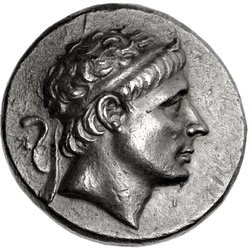| Antiochus II Theos | |
|---|---|
| Basileus | |
 Silver tetradrachm of Antiochus II Theos, minted in Tarsus, featuring a portrait of Antiochus on the obverse. SC 561 | |
| Basileus of the Seleucid Empire | |
| Reign | 2 June 261 – July 246 BC |
| Predecessor | Antiochus I Soter |
| Successor | Seleucus II Callinicus |
| Born | 286 BC Syria |
| Died | early July 246 BC (aged 39–40) Asia Minor (modern-day Turkey) |
| Spouse | Laodice I Berenice |
| Issue | with Laodice: Seleucus II Callinicus Antiochus Hierax Apama Stratonice of Cappadocia Laodice with Berenice: Antiochus |
| Dynasty | Seleucid dynasty |
| Father | Antiochus I Soter |
| Mother | Stratonice of Syria |
| Religion | Greek polytheism |




Antiochus II Theos (‹See Tfd›Greek: Ἀντίοχος ὁ Θεός, Antíochos ho Theós, meaning "Antiochus the God"; 286 – July 246 BC) was a Greek king of the Hellenistic Seleucid Empire who reigned from 261 to 246 BC.[2] He succeeded his father Antiochus I Soter in the winter of 262–61 BC. He was the younger son of Antiochus I and princess Stratonice, the daughter of Demetrius Poliorcetes.[3]
Antiochus II was a forceful personality who in his lifetime largely succeeded to hold the sprawling Seleucid realm intact. However his fateful decision to repudiate his first wife Laodice and marry a Ptolemaic princess Berenice as part of a peace treaty led to a succession struggle after his death that would shake the empire's foundations and cause large territorial losses.
- ^ Inscriptions of Asoka. New Edition by E. Hultzsch (in Sanskrit). 1925. p. 3.
- ^ "Antiochus II Theos". Livius.
- ^ Chisholm, Hugh, ed. (1911). . Encyclopædia Britannica. Vol. 24 (11th ed.). Cambridge University Press. p. 604.